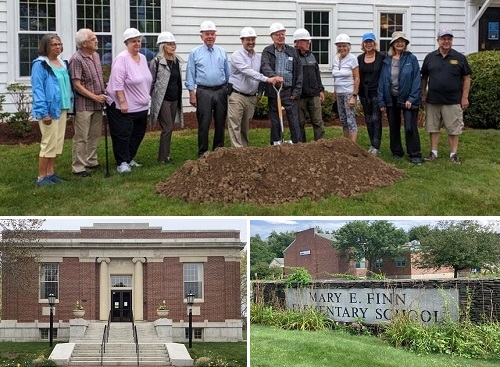Above: The Senior Center celebrated “breaking ground” for a small addition. Meanwhile, multiple efforts are underway on overlapping municipal building projects, including a Library building project and the Town’s look into a potential Community Center at Finn School. (images top contributed, bottom L-R from Facebook and by Beth Melo)
The Council on Aging was happy to announce on Monday that work is kicking off for its small addition to the Southborough Senior Center.
Sharing the news is a good time to give an overdue update on overlapping research into potential Town facilities projects: renovating/rebuilding Neary, closing Finn School for conversion to a Community Center, and a Library building/renovation project.
(I’ll also soon be sharing an update on the Town House restoration work in process. But I’m waiting for some more details on that one.)
Senior Center Addition
 As I’ve previously shared, the Town is using ARPA (American Rescue Plan Act) funds to add about 700 sq ft “Community Room” onto the front of Cordaville Hall. It’s a project the Council on Aging has long been pushing for to meet needs of the growing senior population in town.
As I’ve previously shared, the Town is using ARPA (American Rescue Plan Act) funds to add about 700 sq ft “Community Room” onto the front of Cordaville Hall. It’s a project the Council on Aging has long been pushing for to meet needs of the growing senior population in town.
 A ceremony on Monday celebrated a “ground breaking” for the digging of the addition’s foundation. The foundation work was contracted out to professionals through the bid process. It is timed for the addition to be completed largely by students in vocational programs at Assabet Valley Regional Technical High School.
A ceremony on Monday celebrated a “ground breaking” for the digging of the addition’s foundation. The foundation work was contracted out to professionals through the bid process. It is timed for the addition to be completed largely by students in vocational programs at Assabet Valley Regional Technical High School.
The COA promotes:
This is the ultimate COA intergenerational program with our young people providing facilities for the town’s senior residents. It provides a good working experience for the students and at the same time saves the town considerable labor costs.
The work should be completed sometime this year. I checked in with the Senior Center Director, Pam Le Francois about how it will impact programs at the center. With school out of session, they can’t yet project when the wall will be broken through. So, they are currently booking fall programs as if there won’t be interruptions, with the knowledge that some may need to be postponed.
As for the facilities need, COA’s announcement explains:
The lounge area is an essential part of every senior center and has been lacking at the senior center. It is a daily social hub and provides a quiet space where town seniors can meet informally to watch TV, read a newspaper, book or magazine, do a jigsaw puzzle or just engage in casual conversation. The adjoining activity space will provide room for additional programming at the busy senior center.
Since many readers may never have stepped inside Cordaville Hall, I should point out that the Senior Center only takes up a portion of the building’s footprint. (The building also houses the Building & Zoning and Health Departments. And due to accessibility issues the upstairs is only used for storage.)
So, the bonus room isn’t expected to provide enough extra space to meet the center’s long term needs. Which leads me to the next topic. . .
Exploration of a future Community Center
As I’ve previously written about, between outdated cramped buildings for departments, and the need for expanded space to offer more programs to the community, the Town was dealing with many potential building/renovation projects in the future. (That includes finding new space to house departments currently in the South Union building, which the Town has been looking to close and possibly convert into affordable housing.)
The Capital committee hoped savings could be found through a project that more widely addressed municipal space needs. They recommended creation of a Community Center Exploration Committee (CCEC).
That committee has been researching a possible Community Center project. The CCEC’s charge included looking at the best use of the current Town-owned buildings or a new site to accommodate Town services and departments. That included the potential repurposing of a school.
Based on earlier efforts, I expected the a major focus of the committee to be on Woodward School. But on May 18th, the committee was told that the School Committee will likely seek to keep Woodward open and they should instead focus on using Finn School. (For more on that, scroll down to the Neary Building Update.)
In the meeting, member Janet Maney discussed competing comments she received about the Senior Center’s needs. After she mentioned the committee’s work at Candidate’s Night, she was approached by attendees. Some seniors pushed that the Senior Center should have its own facility like in many other towns. They didn’t want to have to share the gym or event rooms. But she also heard from residents worried about taxes increasing if the Town took on building projects.
The group debated what the consultant they contracted for a study should report on. In the end they agreed on comparing costs for individual and combined building projects (excluding property costs).
Under the contract previously funded for Capital’s municipal needs study, consultant DRA will put together a new report for the committee. DRA will project what an entirely new building that combined the Library, Recreation, and Senior Center would cost. They’ll compare that to high level costs for separate buildings for each. They’ll also evaluate converting Finn to address those combined needs, plus potentially Youth and Family Services and/or other Town departments.
In addition to the costs, the consultant will provide conceptual plans and report on pros and cons for each scenario.
Some readers might be surprised that new Library space is part of the discussion. On that note. . .
Library Building Project?
The Board of Library Trustees advocate that additional space is needed for Library resources and programs. Given the infrequency of state funding cycles, and how long a project takes, the Board already took its first steps to pursue a grant this spring.
In April, the Select Board approved the Trustees’ request to submit a “Letter of Intent” to the Mass Board of Library Commissioners (MBLC) to apply for the next round of construction grants. The letter deadline was this spring. The actual application wouldn’t be submitted until May 2024.
Actually applying for a planning and design grant next year would require Town Meeting approval. Although the state could award around $100K in reimbursement, the Town would have to pick up a share of the cost. Before applying, the Trustees must first map out the next 20 years of services to the public. As part of that effort, the Library will soon be issuing a survey and holding public forums to solicit feedback.
In addition to overlapping the CCEC’s work, this potential project is complicated by the MBLC’s restrictions and the Library’s own property restrictions.
The Main Street facing section of the library is a historic building, recently restored using Community Preservation Act funds. As part of that project, the Town had to agree to a Preservation Restriction on the original section of the building. In addition, the property has a deed restriction which voters were told requires the building can only be used as a library.
Renovating the building to add space would seem to be the natural solution, but. . .
Because renovations of old buildings can cost more, the MBLC requires the Town to also research building an entirely new library. Even if the Town decided that we’re better off going our own way without a state match, the location of the septic combined with water issues on the property limits how much the building footprint could be increased.
The Select Board won’t necessarily support a grant application next year. But since the grant cycle for libraries is about seven years, board agreed it made sense to get work started in parallel to the CCEC’s research.
Of course the CCEC’s work was already parallel to the committee studying another municipal building project — to renovate and/or consolidate Southborough elementary schools. . .
Neary Building Committee Update
This spring, the Neary Building Committee announced that it had entered the Feasibility Study phase, voters approved last year for a school building project. The project would focus on the possible renovation or rebuilding of Neary School.
Voters were told that the costs for replacing the roof and other maintenance issues with the school built in 1970 would be high enough to trigger ADA compliance issues. Dealing with those on our own would be more expensive than a renovation/rebuilding project with a state match.
Part of that study looks at closing one of the lower Southborough schools based on declined enrollments and a study of projected future enrollments.
To get the Mass School Board Authority’s support for a project with matching funds, the administration needs to explain what would happen to the school the state previously invested in. That’s part of the reason the CECC was asked to study repurposing Woodward as a municipal building.
In May, Neary Building Committee Chair Jason Malinowski told the CECC, which he also chairs, to instead focus on Finn. He explained that that the MSBA wasn’t keen on helping to fund a project that would entail closing the Southborough school that the state most recently helped Southborough rebuild (in 2004).
But, the MSBA (and Superintendent) purportedly didn’t have a problem with potentially closing our oldest school, Finn. (The original section of the Finn dates back to 1965, and the renovation with additions was completed in 2002, before the MSBA was established.)
One wrinkle that Town officials are trying to grapple with is the possibility of underestimated enrollments based on issues on the horizon that aren’t in the enrollment study. (What if we close a school, then discover the space was needed after all?)
Developers are pursuing three potential 40B multi-family housing projects (Park Central and Ferris developments). The state is pushing the Town to adopt zoning bylaws to increase multi-family housing by right. And Town officials are looking at ways to increase affordable housing in Southborough.
The Select Board has frequently mentioned the need to estimate the number of school aged children these projects might add to enrollment projections. Yet, under the MSBA guidelines, the potential impacts of those factors are too hypothetical at this time to be included in the district’s enrollment projections.
In July, the Select Board approved a revised charge for the committee to reduce the number of At-Large seats from four to two (based on vacancies) to make it easier for the board to meet.
Earlier in the month, a subcommittee voted to recommend an Owner’s Project Manager that the MSBA will have to approve. Members did run into some process issues. But it appears after a greenlight from the school’s counsel, they were able to recommend the vendor they wanted.** They also voted on a backup OPM if negotiations with their first choice stalls.
Part of the OPM’s responsibilities will be to hire a designer.
*The municipal-space needs evaluation work began under a subcommittee of the Capital Planning Committee before it was replaced by the standing Capital Improvement & Planning Committee.
**The Neary Building OPM Subcommittee discussed the fact that the scoring methodology ranked one vendor slightly higher than the other. However, they had also included that references would be considered, and members found that the other vendor’s references were far and away better. Initially they worried that they would legally have to go with the higher score.


